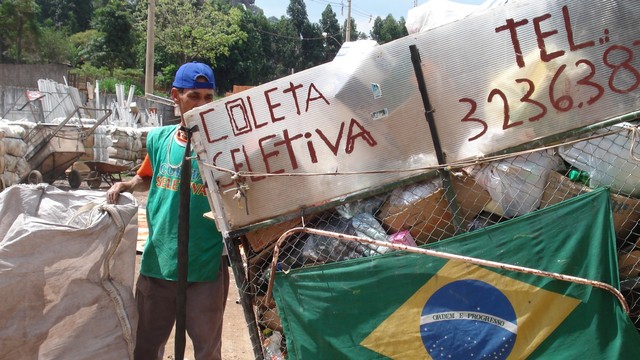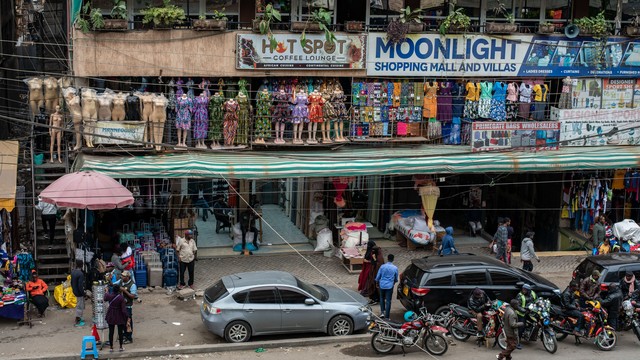Lessons in informality from Kenya's dairy sector
Informal markets are at the heart of many developing country economies, but how can authorities work with the informal sector? A training and certification scheme for Kenya's informal dairy sector provides valuable policy lessons.


A typical Kenya milk bar. Packaged milk in supermarkets has been found to be no better at meeting food safety standards than raw milk sold from kiosks (Photo: International Livestock Research Institute, Creative Commons, via Flickr)
Kenya's informal dairy markets are central to the livelihoods, food security and nutrition of the majority of its citizens, particularly the poor, women and children.
Kenya's informal dairy market is significant in size – 86 per cent of Kenya's milk is sold by unorganised, small-scale businesses in informal markets or consumed directly at home. The sector generates 70 per cent of the 40,000 jobs in dairy marketing and processing (PDF).
IIED has been working in partnership with the International Livestock Research Institute in Kenya to explore the impacts of efforts to govern Kenya's dairy sector in a way that works with, rather than against, informal, small-scale milk vendors. We looked at the impact on milk vendors, on food safety and on sustainability, with the findings published in the final briefing in a series on innovations in policy approaches to informality.
Our research offers lessons for key stakeholders in the Kenyan context, but also for policymakers in other developing countries where informal economies are at their heart.
Indeed, Kenya is not unique in the importance of its informal sector for the country's economy and food provision – informal dairy markets also dominate in Uganda, Rwanda not to mention India, the world's largest dairy producer.
And informal markets more broadly – in agriculture, street vending, forestry and mining – provide jobs and incomes in many developing countries. We simply can't ignore the resilience and dynamism of the informal economy, despite its well-known negative aspects.
A preferred choice, despite food safety concerns
Kenya's per capita consumption of milk is among the highest in Africa. Despite government campaigns to promote packaged, pasteurised milk from the formal sector, raw milk remains more popular. It is cheaper, has a higher fat content, is widely available and can be bought in variable quantities. The formal sector faces high operating costs (PDF), and consequently offers a lower price to farmers and a higher price to consumers.
The dominant perception is that milk sold in the informal sector is more of a health hazard than pasteurised milk in the formal sector. But, in Kenya, packaged milk in supermarkets was found to be no better at meeting food safety standards than raw milk sold from kiosks or door-to-door.
Milk in both Kenya's informal and formal sectors often does not meet microbial standards, but because it is boiled or consumed quickly, the risk of disease for consumers is low.
A need for 'light-touch' approaches to formalisation
Because of the large number of informal small operators, previous attempts to improve food safety in the Kenyan dairy market through regulation and inspection have been unsuccessful (PDF). New approaches were needed.
The Kenyan Dairy Board (KDB, the government regulator), with support from a local NGO and DFID, attempted a 'light-touch' approach. They oversaw a training and certification scheme linked to licensing, focusing on hygienic milk handling, quality control and entrepreneurship.
The scheme was designed with small-scale milk vendors at front and centre – with low fees that the traders could pay themselves to ensure the scheme was not reliant on donor funding; short training sessions to avoid loss of earnings; with realistic goals, providing guidance on milk safety practices that vendors actually had the power to change.
Initial results from the forthcoming IIED/ILRI study suggest that the training improved vendors' milk handling and preservation skills and their ability to judge the quality of milk from suppliers, leading to less waste. The training also encouraged vendors to add value to their milk products which increased incomes (e.g. by producing yoghurt).
Vendors who completed the training received a certificate that helps them obtain a milk vending licence, which meant they no longer risked being fined by KDB officials. Their businesses improved as they had more satisfied and loyal customers, ensuring a more regular income. Quality demands were also pushed down the supply chain, with consumers and milk sellers in a position to choose and demand higher-quality milk from producers.
But the scheme has also faced a number of challenges, which limited reach and uptake. There are a number of reasons for this – including a lack of resources and manpower within the KDB, pressure from the formal sector to ignore the informal sector, a failure to change policy at national level, poor awareness levels among traders and trainers, and insufficient promotion.
Though the scheme has had mixed results, we believe it offers valuable lessons for policymakers seeking to address informal sectors both in Kenya and elsewhere.
Key lessons
Government players need to better understand food systems and informal markets: food sold in the informal sector is not necessarily risky and food in the formal sector is not necessarily safe. Informal markets are essential for food security and will be a feature of economies in many developing countries for a long time yet.
Strengthening and complicating regulations and increasing bureaucracy places a burden on industry and usually doesn't work. Policymakers should look at the need for business licences and permits for street vendors, and work across government authorities to simplify the number and types required to operate legally.
A light-touch approach can be more effective, affordable and politically acceptable than heavy-handed interventions. The Kenyan scheme demonstrates that these approaches can help the government to protect public health, support the livelihoods of producers and traders and increase the availability of milk to nutritionally insecure households.
But to ensure the sustainability of these 'new' approaches, governments must make a long-term commitment to invest the resources needed. Vested interests, such as strong corporate power, can work against more effective and inclusive policies, while also undermining other government priorities such as public health and nutrition or poverty alleviation.
Strengthening milk traders associations could help bring their perspectives to the policy arena and help counter vested interests. NGOs can have an important role to play in advocating for those in the value chain who do not have a voice.
With political will, these lessons can provide an inclusive way of approaching informality.
Emma Blackmore (emma.blackmore@iied.org) is a consultant researcher in IIED's Sustainable Markets Group.
Related resource:
Legitimising informal markets: a case study of the dairy sector in Kenya, Emma Blackmore, Silvia Alonso, Delia Grace (2015), IIED Briefing paper


